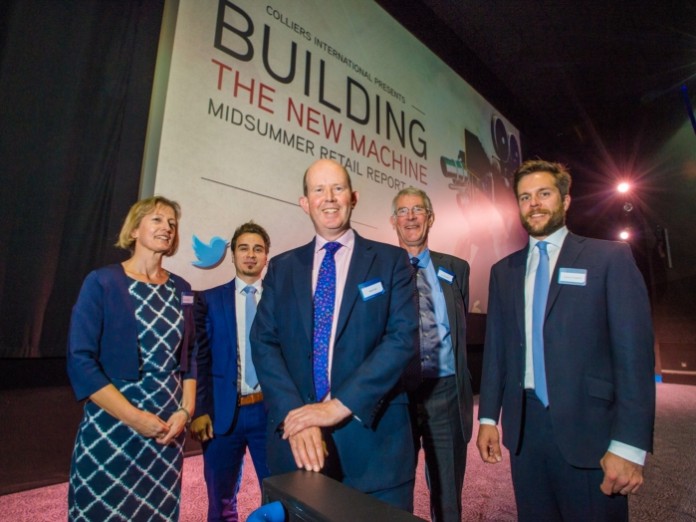
Out-of-town retail has become a shopping success story in the South West, according to a report from commercial property specialist Colliers International.
It shows there is just over 1 million sq ft of out-of-town shopping space – known as retail warehousing – coming through in the South West over the next three years, and some of the most significant schemes are in Devon and Cornwall.
The annual Colliers International Midsummer Retail Report (MSRR) shows that major schemes at Truro and St Austell are expected to open in 2018 along with the long awaited Ikea at Exeter. Bulky goods schemes are planned at Devonshire Park in Paignton and Plymouth Gateway Retail Park in 2017, and the report also anticipates the launch of the Kingsley Village Retail Park redevelopment in Newquay in the same year.
Nick Turk, retail director at Colliers International, said: “Across the UK, out-of-town shopping environments are increasingly popular due to their free parking, enhanced food offer and the ability to offer easy click-and-collect access.
“The market reports that there is good retailer demand for new out-of-town retailing space in strong locations. However, the schemes often face stiff competition from residential development. Last year, no new out-of-town retail developments were completed south of Banbury, which makes the number of new schemes scheduled to launch in Devon and Cornwall all the more significant.”
The Colliers report – which had its official South West launch at Showcase Cinema de Lux in Bristol – is the most comprehensive annual review of the UK shopping scene and monitors rents and empty shops across the country.
Of the 421 locations tracked by the research – 57 of which are in the South West and South Wales – rents in 78 per cent remained stable in the year to the end of April while they rose in another 17 per cent.
This year’s Midsummer Retail Report is entitled ‘Building the New Machine’, and examines how UK retailing and the commercial property sector which supports it are responding to the radically altered shopping landscape. Mr Turk highlighted Bristol, Plymouth and Truro as success stories.
He said Truro had been described as a ‘diamond’ town by a retailer looking for new stores, and that Colliers had seen a variety of new entrants wanting to take space in “this affluent capital of Cornwall”.
He said: “The retail warehouse market is all about latent demand with various developers with about 400,000 sq ft of potential retail warehousing chasing about 150,000 sq ft of tenants. The latest deal saw DFS pay £20 per sq ft at Threemilestone for a 16,000 sq ft unit for 15 years.”
The Colliers International report identifies strong retail activity in Plymouth, Devon, where a 100,000 sq ft leisure extension to Drake Circus is expected to launch in 2018.
Across the 36 towns in the region positive nominal rental growth of 1.0% was identified, with Plymouth one of only three centres to show increasing rents. Plymouth was also the only centre in the South West to experience rental growth in 2015.
The Midsummer Retail Report also reveals that the number of empty retail units in Plymouth city centre decreased significantly between April 2015 and April 2016, dropping from 12.5% to 8.6% of units driven by a significant improvement on secondary pitches.
He continued: “Plymouth is a good example of what we mean by the “new machine” – rents in and around Drake Circus have increased whereas what was previously a good retail pitch along New George Street is now only achieving rents at 50% of prime.
“Bookending the main retail area are two mixed use schemes – the new BL bus station scheme with a cinema and 14 restaurants. Indeed as a further sign of confidence in the city, BL bought up a £70m chunk of New George Street from M&G so linking their various ownerships.
“At the other end of New George Street, the old Derry’s department store is no more as the new owners, Thames Bank, build a scheme with 500 student rooms and a 100 bed hotel. Colliers are acting for Thames Bank on the whole and are talking to a number of A3 and gym operators on the ground floor units. This will be delivered during 2018.
“Therefore poorer or redundant retail is being removed from the picture and replaced with mixed use schemes responding to demand for centrally placed student living, budget hotels, gyms and the continuing increase in eating out – especially amongst the under 35 year olds. It also tells us that only the best department stores work – not forgetting the biggest department store – the Internet.”
A leading commercial property specialist has identified Bristol as one of the success stories of the South West in adapting to the changing demands of modern consumers.
According to the latest Midsummer Retail Report (MSRR) from real estate advisor Colliers International, leading shopping locations in the greater Bristol area have been flourishing at a time when UK retailing and the commercial property sector which supports it have been facing radically altered shopping landscape.
Mr Turk also identified Bristol’s achievement in attracting a combination of retail and leisure operators, and added: “A 100,000 sq ft extension to Cribbs Causeway is on the cards and that is currently going through the planning process, showing how bullish the owners are about this scheme.”
He said that research by had Colliers identified a number of trends which were leading to a steady rise in the retail out-of-town sector.
“Increasingly, operators see retail park stores in the same space as the rest of their portfolio, as high-street brands have moved heavily into the out-of-town sector. This is on the back of landlords gradually widening planning restrictions on parks to allow non-bulky users,” he said.
“Finally retail warehousing developments on the edge of city centre sites and greater leisure provision on these parks are challenging the concept of retail warehousing as being “out of town” – often with a detrimental effect on town centres.”
He said this blurring of the boundary had resulted in increasing demand as more retailers considered retail parks as a viable extension of their portfolio, while at the same time customers have appreciated the benefits of shopping out-of-town shopping – resulting in rising footfall in retail parks over the last two years which is in contrast to both shopping centres and the high street.
“Retail warehousing has weathered the effect of on-line retailing as a result of low fuel prices, the suitability of retail warehousing to Click and Collect and the greater diversity of occupiers in retail parks, including restaurants.
“Value retailers have continued to expand but the shortage of cheaper accommodation has slowed this expansion down. Over the last seven to eight years, these value operators absorbed many units between five and 12,000 sq. ft. whereas Homeware brands such as Plymouth-based The Range and Dunelm Mill occupied many of the larger voids. The number of openings in 2015 was down but still at 63, they form the biggest category of retailers taking space out of town.”



















